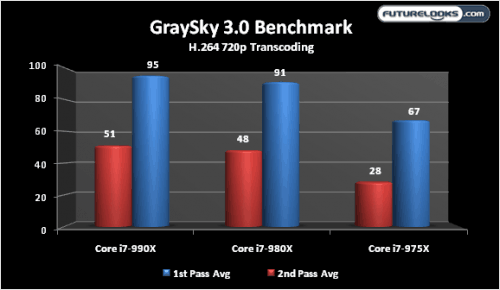Cinebench R11.5
Rendering in this benchmark is very CPU intensive and sensitive to things like CPU frequencies and any special tuning.
At stock settings, the DX58SO2 is just a little better tuned probably due to BIOS and platform updates. However, the UD5 is a little more aggressive with overclocking giving either processor a healthy 4.4GHz frequency. Remember, the S02 likes 4.3GHz which affects rendering performance.
Media Espresso 6
ME6 has been added to the CPU test suite as it shows us tangible benefits of processor and video performance while transcoding videos. Results were record with hardware acceleration on and off. We tossed in the Core i7-975X for a little extra comparison.
As you can see, there is a slight performance gain between the 9xxXE CPUs. This may seem like a long time, but the video took just over 2 minutes without HWA. With HWA, we see the DX58SO2 can make efficient use of all the system’s resources.
GraySky 3.0 Benchmark
This is a free pre-packaged benchmark that converts a video file in two main passes. It uses all of the system’s resources, especially the CPU. Again, the smaller 975X sibling was added for a little more comparison.
There is no arguing that 6 cores with a total of 12 threads will make short work of transcoding, or anything for that matter. The 990X just slightly out paces the 980X which was to be expected.
3DMark11
We had to take single and SLI video performance for a spin. Overall, stock performance is still very close. Overclocking still gives the UD5 the advantage. However, if you’re not one to bother with overclocking, then you’ll be pleasantly pleased.
Battlefield 2 Bad Company 2
Someone asked what’s the benefit of high performance parts are over bang for buck parts. Not only does a massive game like BC2 load quicker, it runs more smoothly using max settings. The frame rate variations were within a couple stock or overclocked. We’re happy to see things so close in this respect.
Unigine Heaven 2.0 Demo
When we’re looking for a benchmark that gives us a system score and fully taxes the 3D performance with some realistic video rendering, this is the benchmark of choice. We took the systems for a spin using only the DX11 high tessellation settings.
There’s very little performance difference here between the platforms. The DX58SO2 does seem to slightly out perform the UD5. It could be due to better tuning and a more up to date chipset implementation. It’s great to see SLI helping the Intel cause.
Now let’s take a closer look at the hardware in the next batch of tests.






